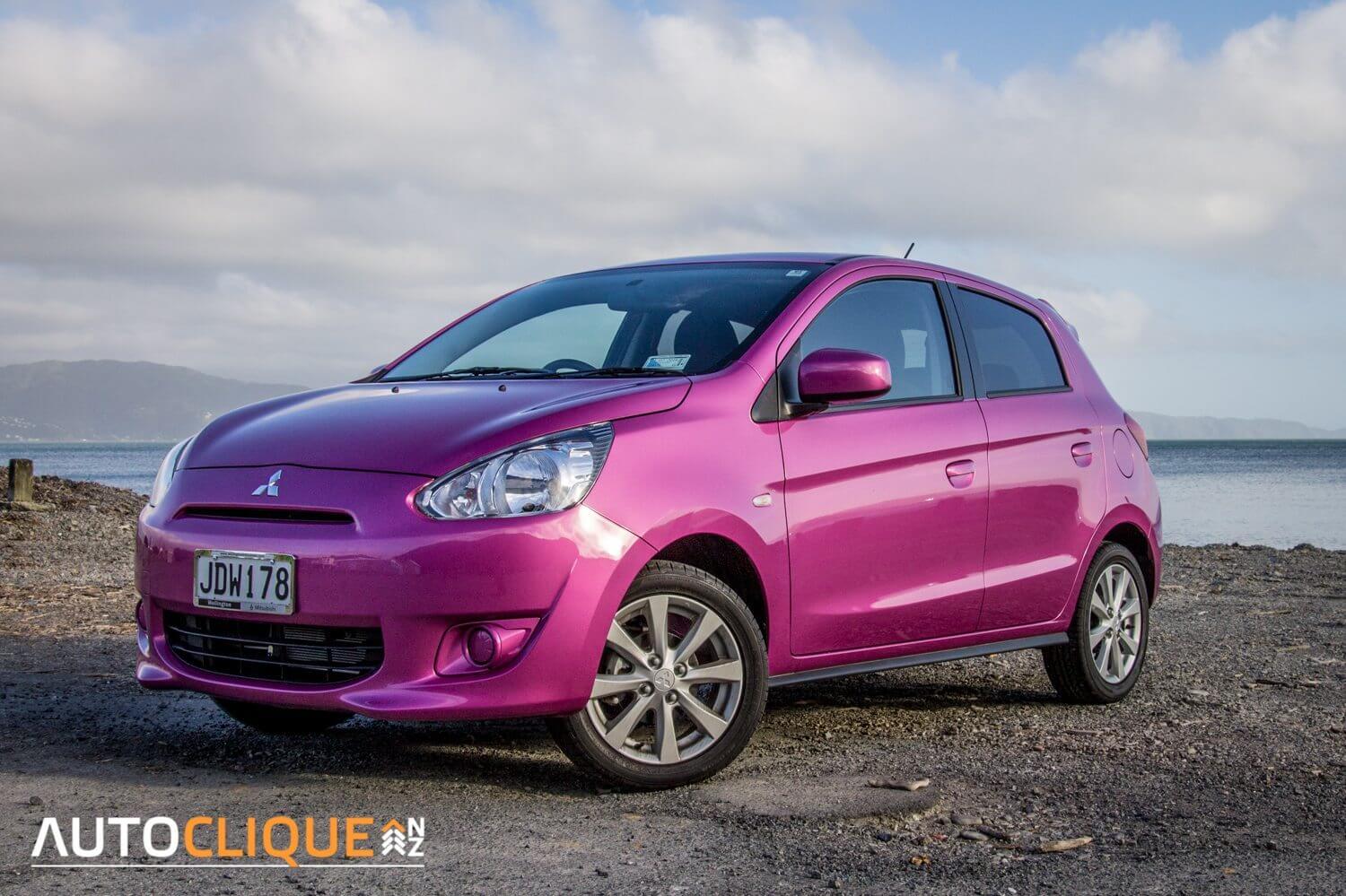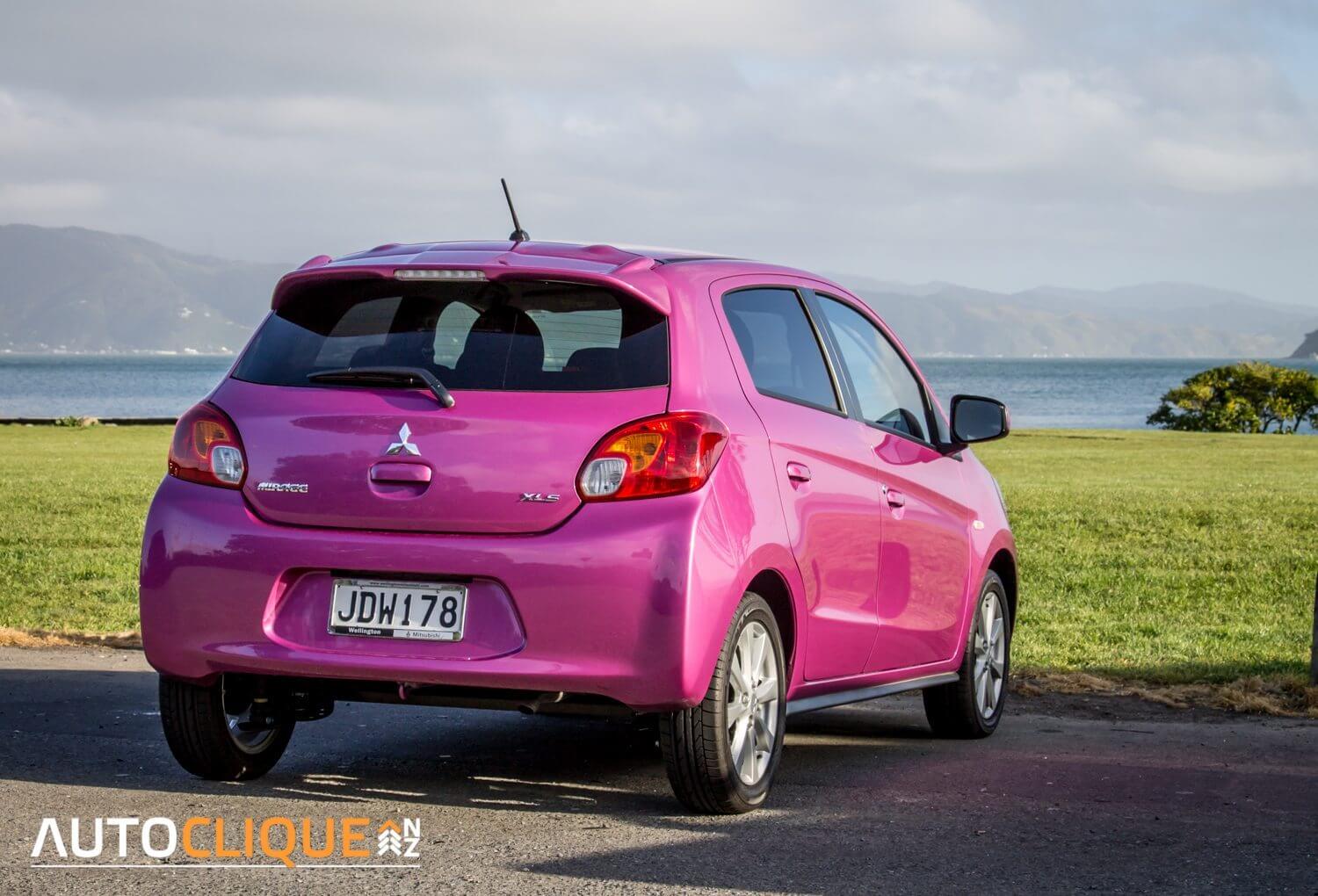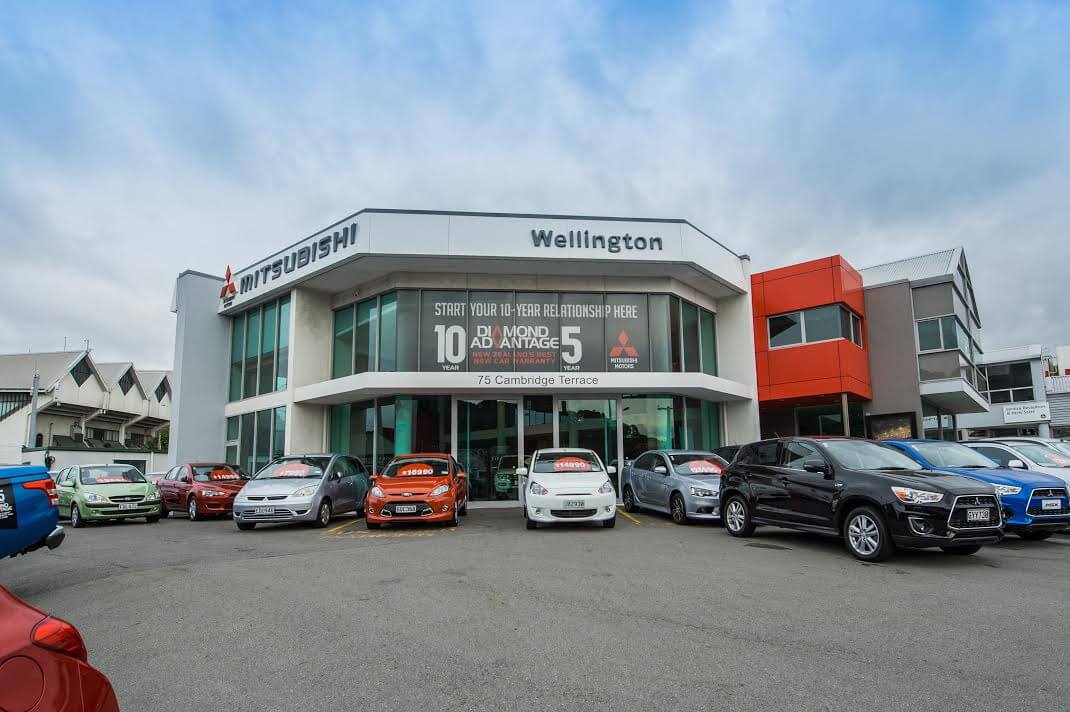The Mitsubishi Mirage has been around since the 1970s and is now in its sixth generation, which went on sale in 2012. Wellington Mitsubishi very kindly lent us their 2015 model demo car for a couple of days for a road test.
When I arrived to collect the car, I was pointed to the very pink little vehicle that you see in the pictures. My first thought was that my daughter would be ecstatic that I had finally managed to get a pink car for her to ride in. She always gleefully points out every pink car that we pass when driving. The colour is actually called Purple Passion, and the Mirage is also available in Wasabi Green, Neptune Blue and Red Velvet. I heartily approve of bright colours for small cars! Oh and if you’re into boring non-colours, white, black and silver are available.
First Impressions
Like most of the small city cars we’ve tested, the Mirage is quite high off the ground, and you can pretty much step sideways into the driver’s seat. The seats are comfortable enough but are very flat. The rear seat is like a flat bench and the fronts have no side bolsters. This becomes obvious the first time you go around a roundabout as the Mirage rolls quite a bit on corners. The flipside of this is that the soft suspension means that you get a great ride, with potholes and bumps being soaked up nicely.
I was pleased to find that the Mirage, despite being an auto, has quite a nippy feel to it. Just how I want a city car to feel, and something that in my opinion most small cars don’t get right. Its 0-100 time is a bit lower than a lot of these small cars, probably because it’s very light at just 895Kg, but Mitsubishi’s CVT also plays a big part in that.
When cruising or idling, the 3 cylinder, 1.2 litre engine is quiet. In fact the first time I stopped at some traffic lights I wondered if it had stop/start as I couldn’t hear it running until the aircon kicked in. Put your foot down and like most little three cylinders, it makes a pleasant growly noise, then rapidly becomes noisy and quite harsh-sounding towards the red line.
The instruments are clear simple with a large central speedo, smaller rev counter on one side and all of the warning lights on the other. There’s a small digital display at the bottom showing the fuel gauge. When you’re driving efficiently a little green ECO light lights up.
What’s it like to live with?
As the petrol gauge was flashing at me I stopped to put some petrol in, and that’s when I realised how small the Mirage is. I had stopped with the back of the car right past the pump. It may only be 3.7m long, but internal space is surprisingly large. Rear legroom is good, and the boot is a decent size too despite having a (space-saver) spare wheel in there.
The interior has an unusual two-tone colour scheme with the bottom of the dash and front door panels in cream plastic, against the rest in dark grey. It looks pretty good but I’m not sure how well it will wear over time. I also noticed that the rear door panels are all grey without the two-tone to match the fronts. The plastics are decent quality for a car in this segment but are a bit hard to the touch.
There are two cup holders in the front but they’re near the floor, so hard to reach when driving. The rear central one behind the handbrake is more accessible for the driver. The front two have a slot cut across them which you can use as a phone holder instead.
There’s air conditioning with simple manual controls – a hot/cold slider and a fan speed switch. All four windows are electric, with one-touch up and down on the driver’s side. And there’s a button to lock the other three windows if you don’t want the kids fiddling with them. The large side mirrors are also electrically adjustable.
The four-speaker stereo is reasonably good if you don’t turn it up too loud. It starts to get a bit fuzzy and distorted at higher volumes. It has bluetooth pairing and USB input, and a power socket for your phone. I thought it was a bit strange that the USB socket is inside the glovebox, but the power socket is outside.
The steering is very light, and the Mirage has a tiny turning circle. It’s easy to do a cheeky U-turn just about anywhere. This combined with the perky throttle response makes it feel great for manoeuvring around town and parking. Visibility is good all around. There’s no reversing camera or sensors, but the wheels are almost at the corners and it’s easy to place the car where you want it.
Out of town, The Mirage is happy to cruise along the motorway at 100, and isn’t bad at getting there on the on ramp. I’m not sure it would be the same with four or five people on board but on my own it was fine. I took the car over Hayward Hill North of Wellington, and found myself actually overtaking other cars on the way up the hill. Granted, said cars were dawdling along well under the limit, but I found myself grinning as I zipped past them in my little low-powered pink car. At higher speeds, the soft suspension can make the car feel a bit floaty over the bumps, but I never got the impression it wasn’t safe.
I even had a bit of fun along the twisties past Whitby – barely getting near the speed limit and with lots of roll around the corners, but the Mirage has a bit of character, and I frequently found myself smiling as I drove it.
It has one of those tiny engines which you can look down through and see the ground below. There’s insulation under the bonnet and around the engine which partly explains its quiet idle. Like the Suzuki Celerio, the Mirage is built in Thailand. There was some interesting looking wiring in the engine bay which made me wonder about how well the car was put together, but in general it feels pretty solid for a small car.
Mitsubishi provide an excellent warranty too. Five-year/130,000km warranty with a 10 year/160,000km drivetrain warranty, and five-year roadside assistance. Mitsubishi are obviously confident in their build quality as this is the best warranty I’ve seen so far on any car in our $20k Challenge.
The Mirage also has a five-star ANCAP safety rating where most of the cars in this segment have four. It has ABS, ASC and EBD, brake assist, hill start assist, seatbelt pre-tensioners, and anchor points for child seats, so safety is well covered.
What it’s up against
Click here for our full $20k Challenge comparison chart
The good and the bad.
| Pros | Cons |
|
|
What do we think?
I really liked the Mirage. It’s small but practical and has enough go to have a little bit of fun. The boot is a decent size, it’s easy to get in and out of. The warranty is excellent. It’s currently on long-term special at $3k off its $19,990 RRP. The only real criticism I have is that is doesn’t have as much technology integrated as some of its peers – things like keyless entry, auto lights, reverse cameras etc. But it does have excellent safety equipment. I think this is a great little city car. Make sure you buy it in a nice bright colour!
Rating – Chevron rating 4 out of 5
Autoclique would like to thank Wellington Mitsubishi for supplying us with the review car.
We would not have been able to complete the $20K Challenge without Wellington Mitsubishi’s kind assistance.
| Vehicle Type | Small City Car |
| Starting Price | $16,995 NZD |
| Tested Price | $16,995 NZD |
| Engine | 1.2 litre DOHC MIVEC 3-Cylinder |
| Transmission | INVECS III CVT |
| 0 – 100 kph | 11.7 seconds |
| Kerb Weight | 895 kg |
| Length x Width x Height | 3710 x 1655 x 1500 mm |
| Cargo Capacity | 235 Litres |
| Fuel Tank | 35 litres |
| ANCAP Safety Ratings | 5 stars |























































